Expert Care for Basal Cell Carcinoma
Basal cell carcinoma (BCC) is the most common form of cancer, with about a million new cases estimated in the U.S. each year. It is rarely a threat to life. Basal cells line the deepest layer of the epidermis. Basal cell carcinomas are malignant growths–tumors–that arise in this layer. Basal cell carcinoma typically affects people of fair complexion with a history of prolonged sun exposure, or repeated episodes of sunburn. The tendency to develop basal cell carcinoma may be inherited. They usually grow slowly over months or years.
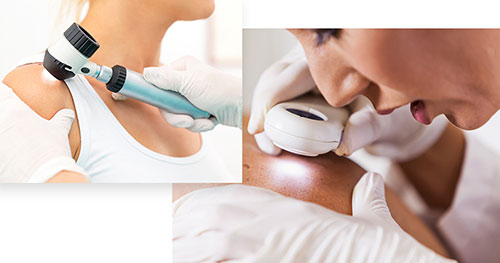
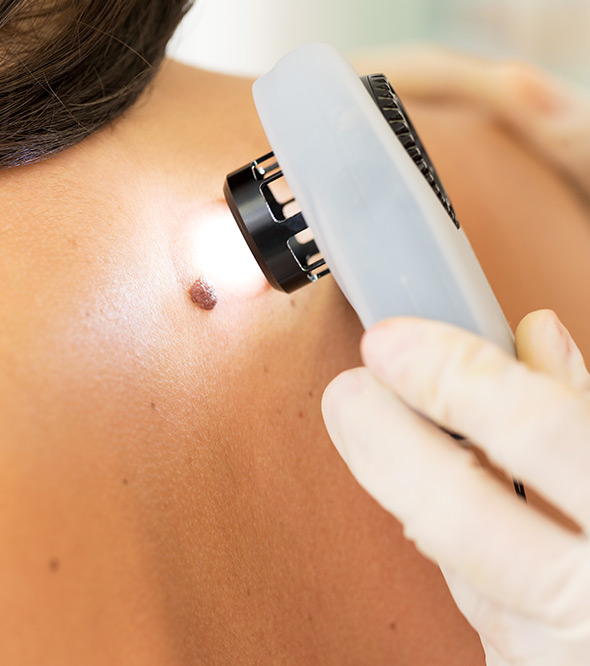
What Causes Basal Cell Carcinoma?
The sun is responsible for over 90 percent of all skin cancers, including BCCs, which occur most frequently on the sun-exposed areas of the body: face, ears, neck, scalp, shoulders and back.
How is Basal Cell Carcinoma Diagnosed?
Basal cell carcinoma can usually be diagnosed with a simple biopsy and is fairly easy to treat when detected early. However, 5 to 10 percent of BCCs can be resistant to treatment or locally aggressive, damaging the skin around them, and sometimes invading bone and cartilage. When not treated quickly, they can be difficult to eliminate. Fortunately, however, this is a cancer that has an extremely low rate of metastasis, and although it can result in scars and disfigurement, it is not usually life threatening.
How is BBC Treated?
The vast majority of BCCs are not serious if detected early and treated quickly. The BCCs that cause trouble are the ones that have been neglected until they have become so thick that they are hard to treat.
There is no one best method to treat all skin cancers and precancers. The choice is determined by many factors, including the location, type, size, whether it is a primary tumor or a recurrent one, the health and preference of the patient, and the physician’s experience with the technique. For example, a treatment that has a high cure rate and is painless but leaves a large scar might be acceptable for a tumor on the body, but not on the face.
Almost all treatments can be performed in the physician’s office or in a special surgical facility. Most skin cancer removal can be done using a local anesthetic. Rarely, extensive tumors may require general anesthesia and hospital admission.
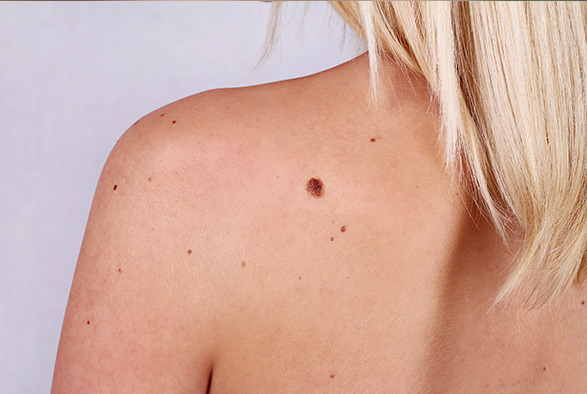
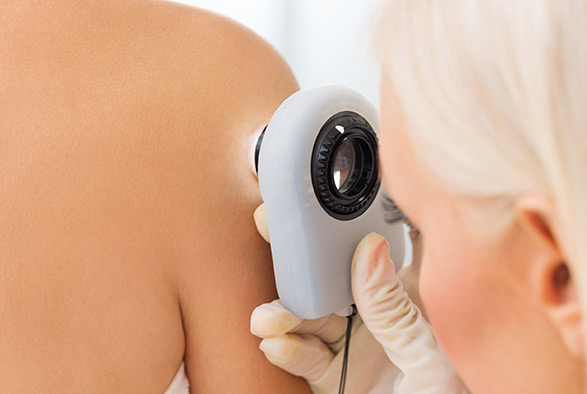
Current Methods of Treating BCC Are:
- Curettage-electrodessication
- Cryosurgery
- Chemotherapy: topical or injection
- Excisional surgery
- Mohs micrographic surgery
- Radiation
- Laser therapy
- Photodynamic therapy
Cure rates for most of the modes of therapy are excellent – from 85 to 99 percent for primary basal cell carcinomas.
Who is At Risk?
Anyone with a history of frequent or intermittently intense sun exposure can develop BCC, but a number of factors increase risk:
Time Spent Outdoors
People who work outdoors – construction workers, groundskeepers, lifeguards, etc. – are at greater risk than people who work indoors, as are those who spend their leisure hours in the sun.
Skin Type
Fair-skinned individuals who sunburn easily and tan minimally or not at all have a higher incidence of skin cancer than dark-skinned individuals. Check our skin type chart to see how at risk you are.
Hours of sunlight
The more hours of sunlight in the day, the greater the incidence of skin cancer. For example, there are more cases in Arizona, Texas and Florida – states that are closer to the equator and get more sun – than in the more northern states of Maine, Oregon and Washington.
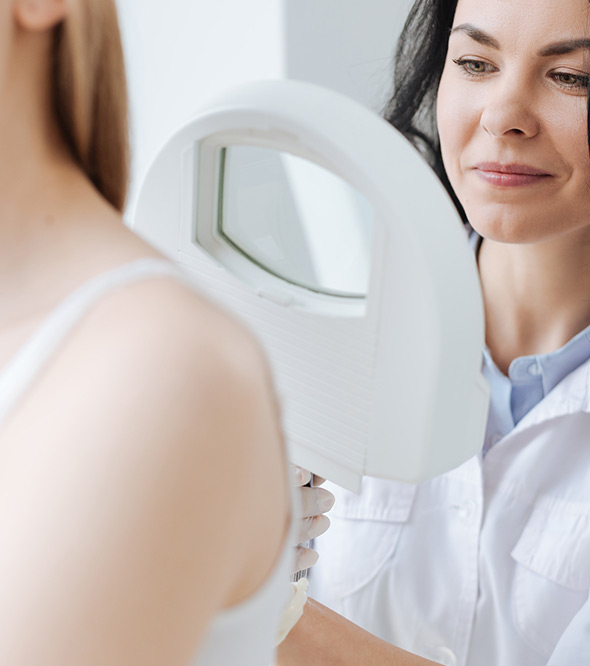
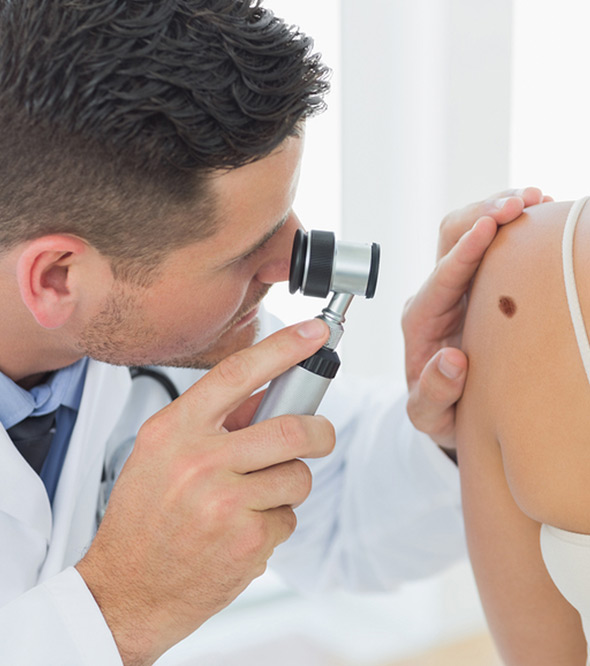
What Are The Warning Signs?
The five most typical characteristics of basal cell carcinoma are shown in the pictures below. Frequently, two or more features are present in one tumor. In addition, BCC sometimes resembles noncancerous skin conditions such as psoriasis or eczema. Only a trained physician can decide for sure. If you observe any of the warning signs or some other change in your skin, consult your physician immediately.
Open Sore
An open sore that bleeds, oozes or crusts and remains open for a few weeks. A persistent, non-healing sore is a very common sign of an early basal cell carcinoma.
Reddish Patch
A reddish patch or irritated area, frequently occurring on the chest, shoulders, arms or legs. Sometimes the patch crusts. It may also itch or hurt. At other times, it persists with no noticeable discomfort.
Shiny Bump
A Shiny Bump or nodule that is pearly or translucent and is often pink, red or white. The bump can also be tan, black or brown, especially in dark-haired people, and can be confused with a mole.
Pink Growth
A Pink Growth with a slightly elevated rolled border and a crusted indentation in the center. As the growth slowly enlarges, tiny blood vessels may develop on the surface.
Scar-Like Area
A Scar-Like Area which is white, yellow or waxy, and often has poorly defined borders. The skin itself appears shiny and taut. This warning sign can indicate the presence of small roots, which make the tumor larger than it appears on the surfac
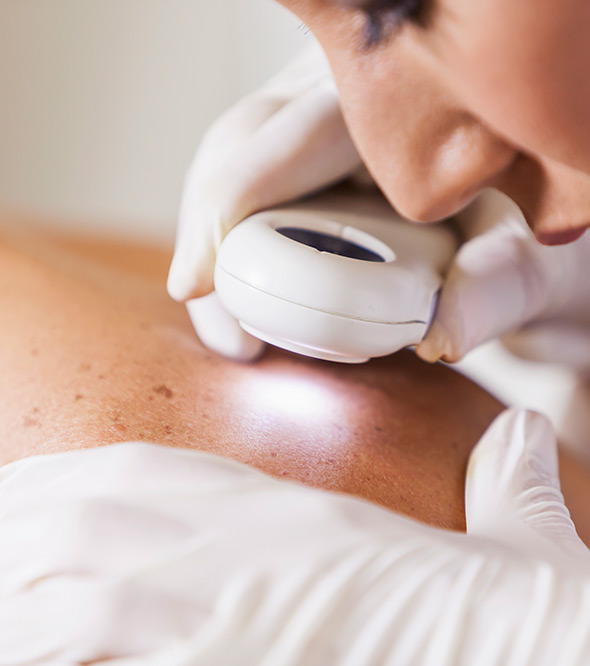
Frequently Asked Questions
Is basal cell carcinoma life-threatening?
Basal cell carcinoma is the most common form of skin cancer and occurs frequently. Basal cell carcinoma is typically easy to treat, grows slowly, and rarely spreads to other parts of the body. It is the least life-threatening form of skin cancer. However, it still is cancer and can cause significant damage to the skin. Since basal cell carcinoma often occurs on the face it can lead to cosmetic problems on the nose, eyes, and ears. Because Basal cell carcinomas grow slowly, most cases are curable and cause minimal damage when caught and treated early.
What is the difference between basal cell carcinoma, squamous cell carcinoma, and melanoma?
Basal cell carcinoma, squamous cell carcinoma, and melanoma are the main types of skin cancer. Most people have heard about melanoma because it is the deadliest form, but it is also the rarest. Melanoma is a discolored patch with suspicious features and it is more common in younger people. Squamous cell carcinoma occurs three times more often than melanoma. This type is less dangerous than melanoma but it can spread to other parts of the body and cause extensive damage. It may be recognized as rough or scaly red patches, raised growths or lumps, open sores or wart-like growths in sun-exposed areas such as the face, hands, neck, and arms. Basal cell carcinoma is the least malignant form of skin cancer. This type grows slowly, rarely spreads and is easy to treat.
When should I see a doctor for basal cell carcinoma?
If you have a suspicious spot on your skin, a mole, birthmark or a patch that you aren’t sure about, we recommend seeing a board-certified dermatologist. Basal cell carcinoma can be diagnosed fairly easily and treatment can be successful when detected early. All types of skin cancers have the best chance of elimination when treated at an early stage. Regular self-examination is especially recommended for people who are at a higher risk. Don’t hesitate to visit a specialized dermatologist if you are concerned about your skin.
